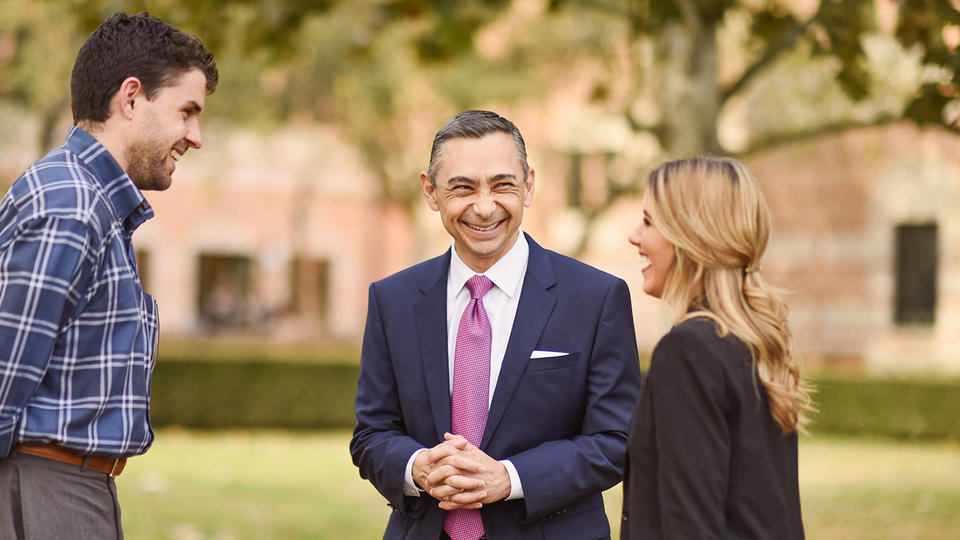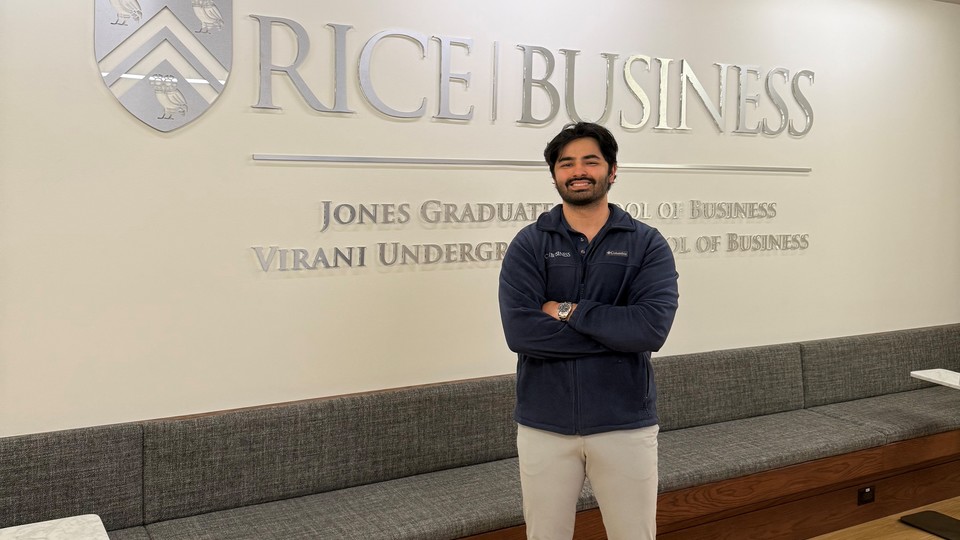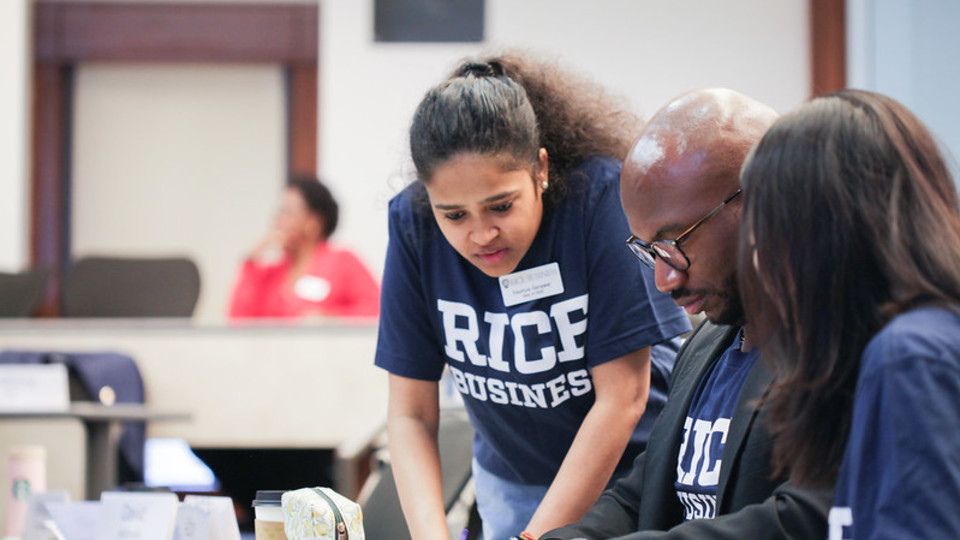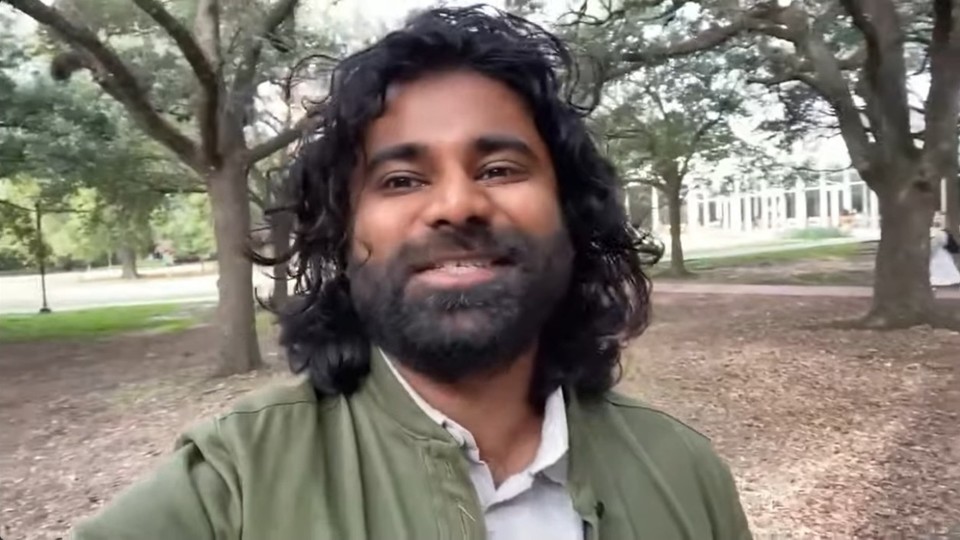
Exponential Growth
Phil Reiser, Professional MBA '19
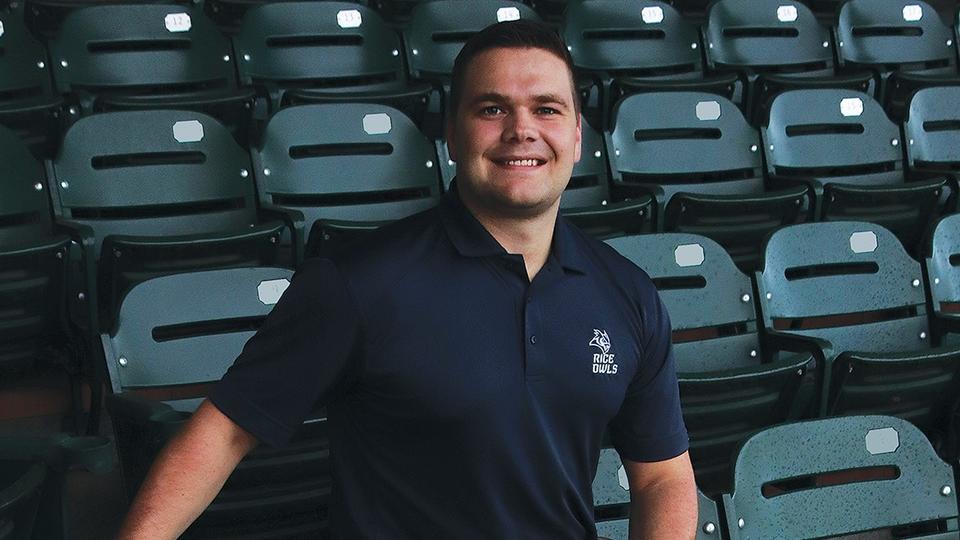
“Over just one year in the MBA program, I transitioned to a new role, developed a model that is being implemented for business analytics questions within ExxonMobil, trained business analysts for the other regions of the U.S., and just recently got a promotion. I have no doubt that the coursework and experiences at Rice contributed to both my accomplishments and promotion.”

Phil Reiser ’19 knew since undergrad at MIT that he wanted to earn an MBA. Next, he needed to choose the right program, full time versus professional. He chose the latter because, “I wanted to have the opportunity to apply what I was learning during my coursework. Rice was the clear choice and the only one I applied to. The fact that it had a physical campus along with surging business school rankings were among my top deciders.” It also didn’t hurt that his sister was finishing up her Ph.D. in bioengineering at Rice at the time and had nothing but great things to say about the campus and culture. A left-handed pitcher and first baseman on MIT’s varsity baseball squad, Phil also majored in chemical engineering and minored in economics. The 25-year-old has been with ExxonMobil for three years.
You May Also Like
Keep Exploring
Striving for More
Adrienne Mangual, Executive MBA '19
“Three things happened. I decided I wanted to do something else, but I wasn’t sure what. When I started looking, a lot of roles preferred an MBA, and I didn’t want that to be a reason I wasn’t considered for a job. Finally, Dean Rodriguez had been my professor at A&M. He was my mentor, encouraged me to pursue investment banking and helped me get an internship with JP Morgan, which led to a full-time job. When I heard that he was going to be the new dean, I thought maybe the time was right to think about going back to get my MBA.”
The daughter of Mexican immigrants, Adrienne Mangual grew up in Lufkin, Texas, was the first in her family to graduate from college and this spring will be the first in her immediate family to earn a graduate degree. Following a 10-year career in investment banking and a five- year career in corporate finance at an oilfield service company, she knew she wanted to do something more when she applied for the EMBA program. She left her job as assistant treasurer and started the EMBA program just before Hurricane Harvey. With a four-year-old and a one-year-old at home, she decided to spend the first year of her transition at home with her kids. The following year she cast a wide net in search for her next role with a focus outside of traditional finance roles. Adrienne is now executive director of strategy and planning for Prime Communications, the largest AT&T authorized retailer in the U.S. In her role, reporting to the CEO and founder, she leads various strategic projects for the company.
You May Also Like
Keep Exploring
Filling in the Gaps
Fareen Elias, Full-Time MBA '19
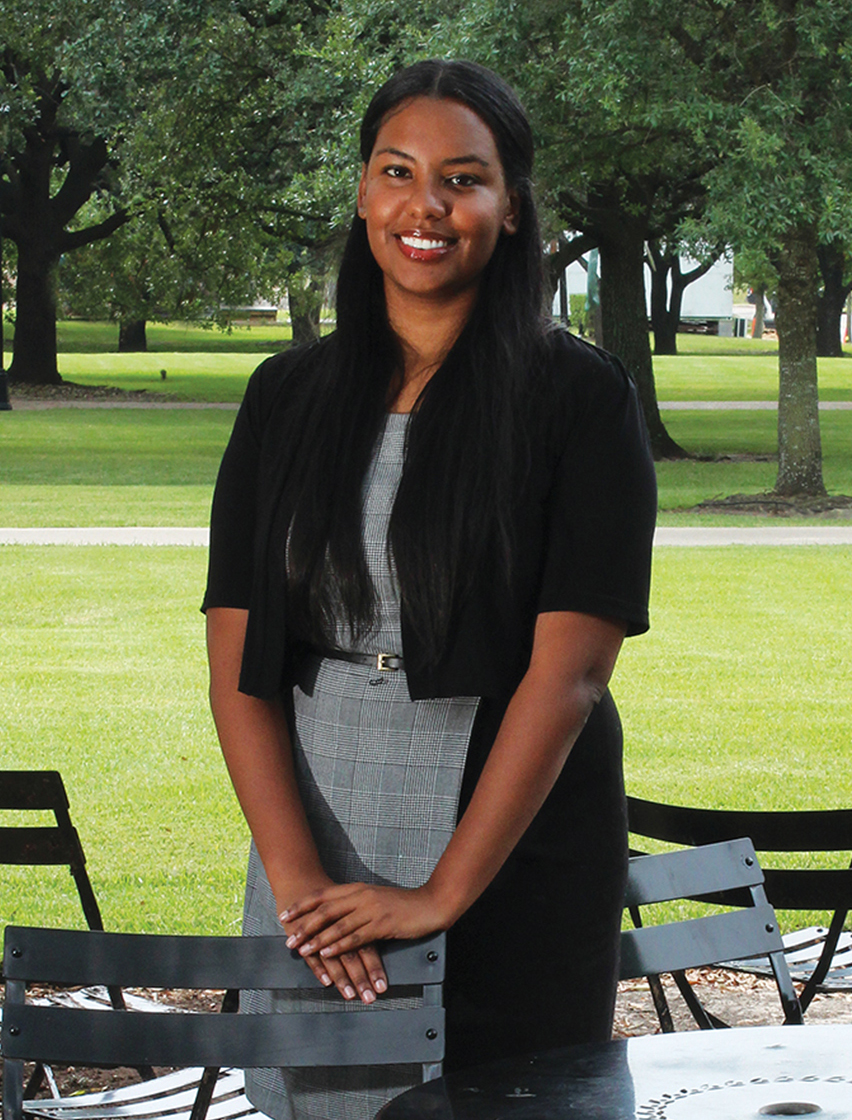
“At Rice, once you apply, you’re already considered for a scholarship. The application process is so arduous. You really put yourself out there. Rice could see my value. It meant a lot to me get the recognition and receive the Crownover Scholarship.”
When Fareen Elias was in high school she came to Rice with Management Leaders of Tomorrow (MLT). She heard a presentation about how 10 major problems in the world could be solved by energy. “I realized I wanted to help solve those problems.” So she went to Texas A&M, majored in geophysics and minored in math and economics. After five years as a support geophysicist at a subsurface imaging software company and witnessing industry joint ventures, consolidations and software developer acquisitions, Fareen became interested in how companies were bought, sold and valued. “I wondered if I could take my operational experience and move to financial services and help energy companies create value.” Working in a startup environment, much of what she learned was self-taught. “I knew there were gaps.” The MBA was her next step. She was accepted at Rice and UT, but “Rice was the dream from the beginning.” And then she got a call that she was a nominee for the Crownover Scholarship. “It was so amazing. To go from the idea of sacrificing two years of income and paying for school, to hearing that you won the scholarship — I cried tears of joy. And Mr. Crownover is amazing. He really opens himself up and gives back to the students. I’m really excited for my next two years here.”
You May Also Like
Keep Exploring
Response Time
What do we owe the people who reach out to us?


By Jennifer Latson
What do we owe the people who reach out to us?
Recently, a man I don’t know emailed me about a story I’d written on loneliness.
The message was brief and vague. “I’d like to connect with you regarding the article you wrote,” he said, adding only that “mental health will be a key initiative we are undertaking” at the large marketing firm where he works.
I’m wary of emails with no clear purpose, since they often seem to lead to long conversations and burdensome requests. Still, I meant to respond. Then I got distracted — by other emails, work demands, a rumor that there was cake in a nearby office — and never got around to it.
A few weeks later, he called my office at Rice University’s Jones Graduate School of Business, where I write about faculty research. When I didn’t answer, he began irately dialing every department in the directory, first insisting that an admissions officer track me down and ultimately demanding to speak with Rice Business Dean Peter Rodriguez — presumably to tattle on me for my email truancy.
People across the building were miffed, and I was mortified that I had set all this in motion. Obviously, it was my fault for not answering the man’s email promptly. But was it? What response do we actually owe the sender of an unsolicited email?
There’s no question that email is a growing burden for many of us. A 2019 study by management professors at the University of Arkansas, Michigan State, Florida International University and the University of Massachusetts found that the average “knowledge worker” — someone who gets paid, at least in part, for thinking — spends more than a quarter of their workweek reading and responding to email.
And while answering email may not seem to require much effort, it is in fact one of our most taxing duties, the researchers found. “E-mail is a unique job demand in that it entails a high workload combined with lower levels of control due to strict workplace norms around being responsive,” they write.
That makes it one of the biggest sources of workplace overload, taking a toll on our wellbeing and our overall productivity. Managers, especially, are drained by the demands of their inboxes, which siphon time away from more critical tasks, the researchers note.
Luckily for me, it’s a battle Dean Rodriguez can relate to.
“I triage aggressively and periodically go on maniacal purges to get to inbox zero. It’s not pretty,” Rodriguez says. “By triage, I mean that I respond right away to anything urgent and to key stakeholders with whom I work closely. This is about half the emails I receive. For the others, I tend to let them linger while I think about how I want to respond. That’s the big delay.”
Still, many of us expect a response to every email we send — and a quick one, at that. Some people argue that it is simply common courtesy to reply to those who reach out to you. All of them. And while the digital age may be to blame for a general decline in courtesy, the fault ultimately rests with email-ignorers — like me.
“In recent years, it’s become more and more ‘acceptable’ to not respond promptly to e-mails, or worse, to not respond at all,” writes Tasha Eurich, an organizational psychologist who heads an executive development firm. “Listen, I get it. We’re all busy. But that’s no excuse for bad behavior. Response time is a non-verbal cue that speaks volumes about who we are, for better or for worse.”
“Responding in a timely manner shows that you are conscientious — organized, dependable and hardworking,” Wharton professor Adam Grant wrote in a recent New York Times op-ed. Not responding quickly — or at all — means you are… not.
“Yes, we’re all overwhelmed with email. One recent survey suggested that the average American’s inbox has 199 unread messages,” writes Grant. “But volume isn’t an excuse for not replying. Ignoring email is an act of incivility.”
It may also mean you’re bad at your job. Researchers have found that one of the surest signs of an ineffective manager is being slow to answer emails, Grant explains. Meanwhile, some of the busiest people are the fastest to respond — and they see slow replies as a red flag in people they might want to work with.
Molly Beck, founder of the podcast creation website Messy.fm and author of the networking guide Reach Out, responds almost instantly to emails, and expects the contractors and vendors she hires to do the same.
“My email philosophy is: If you are on top of your inbox, you are on top of your life,” she wrote me — approximately 90 seconds after I emailed her. “It's perfectly fine to respond to an email with ‘Thanks for reaching out, but this isn’t a fit/not something I need right now/not something I have the bandwidth to do right.’ Responding to every email just means you respond to every email, not that you say yes to every request.”
Rodriguez agrees that every email — unless it’s an unsolicited sales pitch — deserves a response. The problem is that responding to everyone cuts down on the time you can devote to each answer.
“I think we’re all uncomfortable with the fundamental tradeoff. You either offer shorter, less useful responses to everyone or just don’t respond at all to a significant number of emails,” he says. “I’ve been trying to emulate a few people I know who handle this well and I’ve been half successful at best. They do a good job of the one-liner responses: ‘Thanks Peter — I’ll get back to you soon.’ Or ‘Interesting. I appreciate your work on this.’ As a response to a lengthy email, these can seem cold or like a subtle brush-off. But I’ve come to see them as the ‘something vs. nothing’ tradeoff a busy inbox creates.”
On the other hand, there are those who believe no response is a legitimate response, just as an Irish goodbye is a perfectly acceptable way to leave a party. In its extreme form, however, not responding becomes ghosting: disappearing from an ongoing conversation in which the other person rightfully expects a response — like when a recruiter actively pursues a job candidate and then cuts off communication completely, never to email again.
More recently, workers themselves have begun ghosting employers, leaving a job without giving notice and not responding to calls, emails or texts, which economists have taken as a sign that the economy is so strong they have no trouble finding new opportunities — and no qualms about burning bridges with previous employers.
This seems like a bad idea, professionally speaking. But any unanswered email could potentially do professional harm. That’s because our default response to being ignored is to take offense — even if the silence was unintentional, says Terri Kurtzberg, a management professor at Rutgers Business School. Often, it’s simply a question of whether the person you emailed was free to respond the moment she received the email — because if not, countless other requests for attention have likely buried it since then.
“Our research shows that attention is more and more divided, and there are more and more requests for our attention. That means we have to prioritize more and that more things slip — and that there are enough other demands for our attention that if one does slip, it doesn’t rise to the surface again,” Kurtzberg says. “It’s coupled with the fact that so many more people can figure out how to get access to us: People can find your email and send you direct requests so easily.”
Personality types factor into our response times, as well. “There are people who will answer within 20 seconds, no matter what time of the day or night, and there are people I call a black hole: You’ll just never ever hear back,” she says.
The 20-second answerers, naturally, tend to expect others to behave the same way. The black holes may not give it much thought.
“Personally, I don’t think it’s a particularly crazy idea making sure every email I receive gets a response within 48 hours, maximum,” Elena Lockett, a marketing assistant at the British firm FM Outsource, writes. “Surely this is the norm?”
But that’s exactly the problem: There are no norms when it comes to email etiquette, Kurtzberg says. “This is one place where our society doesn’t have a rule yet,” she explains. “It’s a little bit of a free-for-all.”
It’s up to each of us to set our own standards regarding who to respond to, and when. There are no right or wrong answers, she says.
But don’t we owe a response to everyone? Is it uncivil to ignore someone, even when it’s a stranger who wants to connect with you — and you don’t?
“Personally, I think it’s not civilized to demand attention from a stranger without an invitation to do so,” Kurtzberg says. “I find telemarketers uncivil in interrupting my day, so I don’t find it uncivil when I hang up on them.”
Of course, there’s no established set of etiquette standards for email senders, either, but it always helps to be considerate of the recipient’s time.
“My least favorite emails are the ones that end with ‘Thoughts?’” Rodriguez says. “Seriously? It always seems like a challenge to show off my insightfulness. Come see me, let’s have a drink or go for a walk. That’s the environment for sharing my thoughts. In an email? It’s either skip all the really good stuff or spend all day working on one message.”
In an ideal world, we’d communicate more in person, or at least by phone. But it takes more initiative to start a conversation those ways, and often a lot more time. Email, however, is still a step above texting, where curt replies are the norm — but there’s an even greater expectation of a quick reply.
“I get more and more texts from work colleagues, and I think this has something to do with the acceptable tone on texts. You’re expected to write one or two lines and that’s good, but there is also the imagined finger-roll-on-desk urgency of a reply,” Rodriguez says. “Sadly, my emoji game is awful. There are no easy wins, it seems.”
Jennifer Latson is a senior editor at Rice Business and the author of “The Boy Who Loved Too Much,” a nonfiction book about a genetic disorder sometimes called the opposite of autism. She finds email difficult.
Never Miss A Story
You May Also Like
Keep Exploring
Scholarships that Give Back
Trey Mattson, Full-Time MBA '18
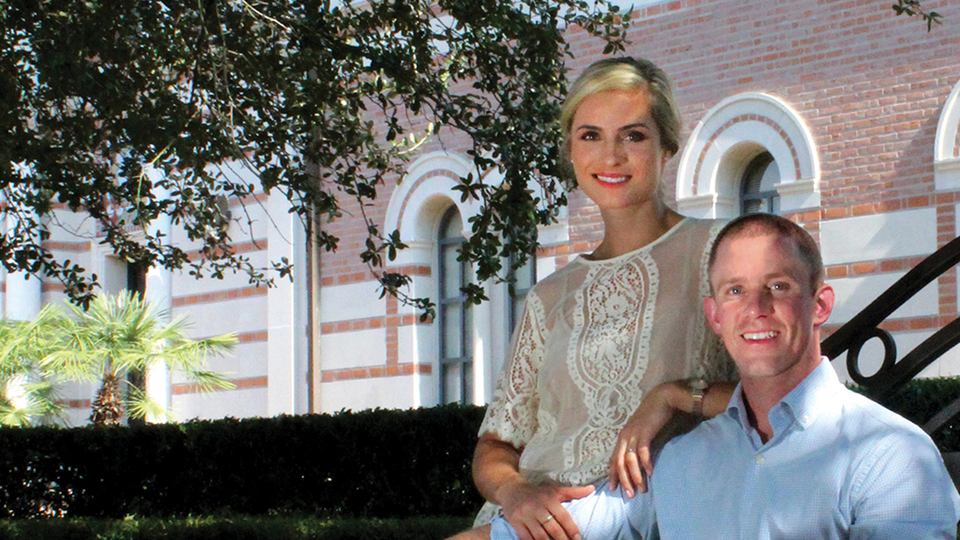
“The Jones Partners Scholarship is an engaged scholarship. You have to reciprocate by going to events, meeting with and reaching out to partners. Attending quarterly board meetings really gives you a behind-the-scenes perspective of the school. It’s been a unique and humbling experience to have received this scholarship.”
A native Houstonian, Trey Mattson chose Penn State for undergrad, just like his dad and two older brothers. He studied finance, met his wife, Kelly, and convinced her to move back to Houston with him so he could tap a career in the oil and gas sector. His first job with Tudor, Pickering, Holt & Co. jump-started his career in energy investment banking and eventually private equity. After five years with TPH, Trey started to think about an MBA, like his brothers, who told him it was the best decision they’d ever made. “I wanted a pause to reevaluate.” And though he looked at “fantastic options,” such as Harvard, Wharton, Stanford, Darden and MIT, the offer of the Jones Partners Scholarship sealed the deal at Rice. Jones Partners is a front facing organization that connects the business school and the Houston business community. Many of their members are alumni. Trey’s summer internship with White Deer Energy, a private equity fund, morphed into an offer for a full-time position after graduation. He will rejoin the firm next summer as a senior associate focused solely on oil and gas investments. He’s pictured here with his wife, Kelly; golden retriever, Cooper; and Rhodesian Ridgeback, Riley.
You May Also Like
Keep Exploring
Discovering New Possibilities
Chris Staffel, Executive MBA '17
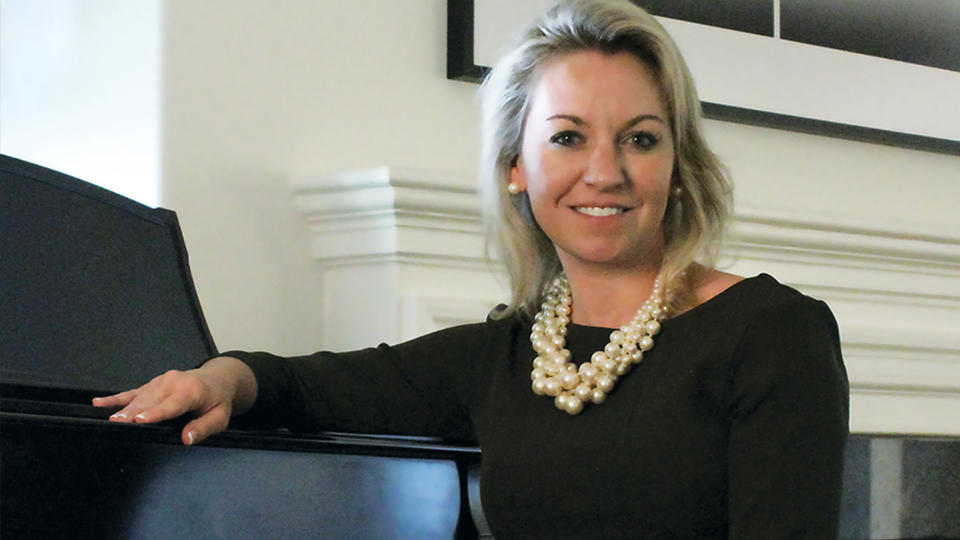
About Chris Staffel, Executive MBA '17
“If you would have told me years ago that I’d be building companies for natural gas pipeline infrastructure, I would have never believed you. I went to a music conservatory in Chicago for my undergraduate degree, followed by an M.F.A. in musical theater and then moved to New York to pursue musical theater … I’ve now started three companies in the midstream energy space.”

A native of San Antonio, Chris Staffel grew up thinking she wanted to be a professional singer. After mastering regional theater and a classical tour throughout Russia and Eastern Europe she got tired of living out of a suitcase and put down roots in New York City. The daily grind of auditions drove her to producing. “I realized I enjoyed the business part of it, equally, if not more than acting.” While she was producing The Dutchman she met two businessmen who were starting a midstream company. “What’s midstream?” she retells it now, laughing. As it turns out, acting and producing isn’t far off from starting and running a company. “You have to raise the capital, hire actors, market the show, and of course … perform.” Even before moving to Houston, she sat in on some classes at Rice and was sold on earning an MBA. “It’s been excellent. I’ve learned so much … The network is incredible.” Since the sale of her company in November, she’s curious about the next global opportunities on the horizon in energy and plans to travel to various emerging markets after graduation. “I want to see where the next possibilities are.”
Keep Exploring
High-Quality Peers
Ernie Mayfield, Executive MBA '18
“By far the highlight for me has been the interaction with my fellow classmates in the EMBA program. To be able to draw from the experience and knowledge base of such a high-quality group of working professionals at similar points in their careers is important to me.”
Lt. Col. Ernest G. Mayfield III flies F-16s out of Ellington Field about three times a week. As part of his job. A graduate of the U.S. Air Force Academy, he has completed more than 17 years as a fighter pilot in the Air Force, two tours in Iraq, and more than 350 hours of combat flying time in a wide range of global joint and multinational aviation missions. This past fall, after becoming director of operations at Ellington Field and keeping the Gulf Coast region safe, Ernie joined Rice Business to pursue an MBA. “I always wanted to get my MBA,” he said. “It was just a matter of when.” Ernie and his wife, Joy — who graduated from the EMBA program in 2006 and was his sister’s best friend growing up in Beaumont — are raising two daughters, age two and four. Despite a no-fail 24/7 homeland defense mission both at work and home, Ernie has loved going back to school. “I’m always excited for class weekends. I find the coursework interesting and relevant not only to today’s business environment but also my own sector in the Department of Defense.”
You May Also Like
Keep Exploring
Family Friendly
Nadia Bollinger, Professional MBA

“My choice to earn an MBA was very deliberate. I had to consider my family in the decision, and I needed a program that would complement my career. Reputation was important so I looked at a lot of programs. When I came to the Rice campus and met with admissions, I got the sense that this felt right. I wanted to have the full experience. I was sold.”

An IT supervisor at ExxonMobil, Nadia Bollinger has worked for the energy company 12 years — since she graduated from Texas A&M. She is used to going to school while working, having earned an M.S. in IT Project Management from UH, but that was before she married and had her daughter. Since then everything has changed and her priorities have shifted. “I want the best life for my family. An MBA made sense.” The self- described Pakistani-Canadian- American wants to be involved beyond the classroom, too. She’s got her eye on the finance club, NAWMBA and the Wright Fund. No matter how she gets involved over the next two years, she says, “I feel like I’m at the right place at the right time.”
You May Also Like
Keep Exploring
Rewarding Experiences
Joey Ammouri, Professional MBA '17
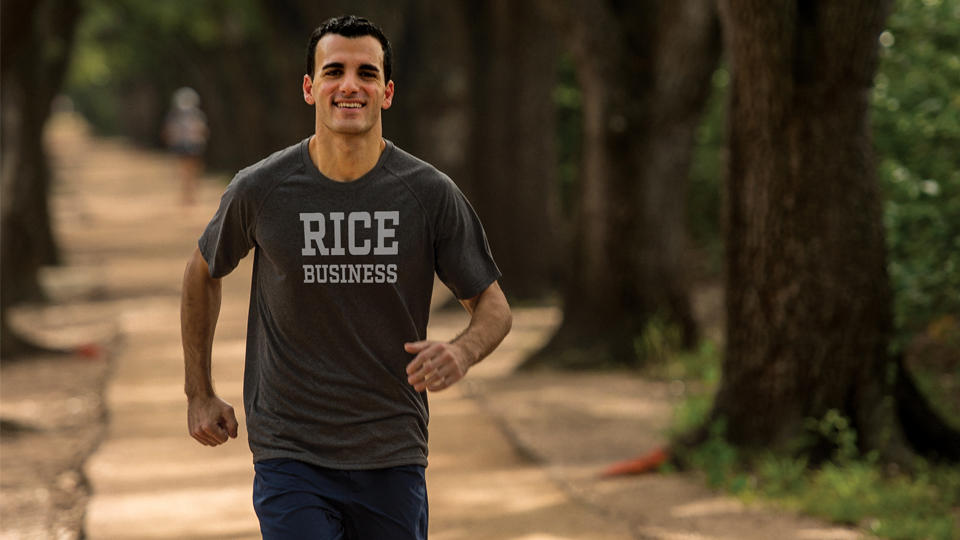
Joey Ammouri, Professional MBA '17
“Rice Business Board Fellows was one of the main reasons I chose to attend Rice. I remember thinking what a unique and amazing opportunity it would be to help further a cause I care about. As Board Fellows president, it has been a truly heartwarming and rewarding experience to share my vision, and expand the school’s reach to serve more nonprofits.”

As a child of immigrants from Nazareth, Joey Ammouri carries with him their drive for success, and selfless passion for giving back and being involved in the community. Along with his position as industrial sales manager at GE, busy social and travel schedule, and passion for running and fitness, Joey is also heavily involved with Big Brothers Big Sisters. He naturally found Rice Business Board Fellows to be the perfect fit when he started business school. Joey was placed with the Positive Coaching Alliance, which partners with youth sports organizations to help kids become “Better Athletes, Better People.” As Board Fellows president, he hopes it will be for others what it’s been for him — a prominent part of his graduate education.
Keep Exploring
Rice Jones Dean On Going STEM: Timing Was Almost ‘Perfectly Wrong’
All Rice University's graduate business programs are now certified as STEM, making Rice Jones the last top-25 U.S. B-school to have a STEM pathway.
